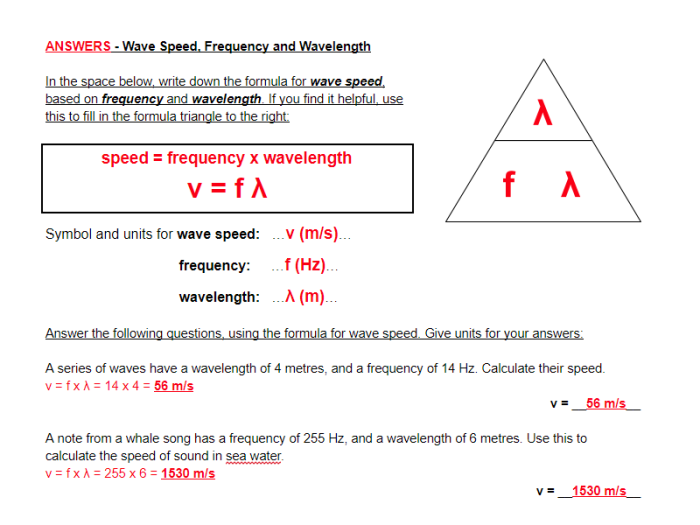The speed frequency wavelength worksheet answers provide a comprehensive understanding of the fundamental concepts of wave properties. This guide delves into the definitions, measurement techniques, calculations, and real-world applications of speed, frequency, and wavelength, empowering readers with a thorough grasp of these essential wave characteristics.
Speed, Frequency, and Wavelength: Speed Frequency Wavelength Worksheet Answers

Speed, frequency, and wavelength are three fundamental properties of waves. Understanding these properties is essential for understanding how waves behave and how they are used in various applications.
Definitions
Speedis the rate at which a wave travels. It is measured in meters per second (m/s).
Frequencyis the number of waves that pass a given point in one second. It is measured in hertz (Hz).
Wavelengthis the distance between two consecutive crests or troughs of a wave. It is measured in meters (m).
Relationship between Speed, Frequency, and Wavelength
The speed, frequency, and wavelength of a wave are related by the following equation:
speed = frequency × wavelength
This equation means that the speed of a wave is equal to the product of its frequency and wavelength.
Measurement
Speed, frequency, and wavelength can be measured using a variety of instruments.
- Speed can be measured using a speedometer or a radar gun.
- Frequency can be measured using a frequency counter.
- Wavelength can be measured using a ruler or a spectrometer.
The following table shows the units of measurement for speed, frequency, and wavelength:
| Property | Unit of Measurement |
|---|---|
| Speed | meters per second (m/s) |
| Frequency | hertz (Hz) |
| Wavelength | meters (m) |
Calculations
Speed, frequency, and wavelength can be calculated using the following formulas:
speed = distance / time
frequency = 1 / period
wavelength = speed / frequency
These formulas can be used to solve a variety of problems involving waves.
Applications
Speed, frequency, and wavelength are used in a variety of applications, including:
- Physics: Speed, frequency, and wavelength are used to study the properties of waves and to understand how they interact with matter.
- Engineering: Speed, frequency, and wavelength are used to design and build a variety of devices, such as antennas, lasers, and radar systems.
- Medicine: Speed, frequency, and wavelength are used to diagnose and treat a variety of medical conditions, such as cancer and heart disease.
Table of Values, Speed frequency wavelength worksheet answers
The following table shows the speed, frequency, and wavelength of different types of waves:
| Type of Wave | Speed (m/s) | Frequency (Hz) | Wavelength (m) |
|---|---|---|---|
| Light waves | 3 × 108 | 4 × 1014 | 7 × 10-7 |
| Sound waves | 343 | 20 | 17 |
| Water waves | 1.5 | 0.1 | 15 |
Answers to Common Questions
What is the relationship between speed, frequency, and wavelength?
Speed, frequency, and wavelength are inversely related. As speed increases, wavelength decreases, and vice versa. Frequency is directly proportional to speed and inversely proportional to wavelength.
How do I calculate the speed of a wave?
Speed is calculated by dividing the distance traveled by the wave by the time taken to travel that distance: speed = distance / time.
What are some real-world applications of speed, frequency, and wavelength?
Speed, frequency, and wavelength have numerous applications in fields such as physics, engineering, and medicine. For example, they are used in radar systems, medical imaging, and telecommunications.